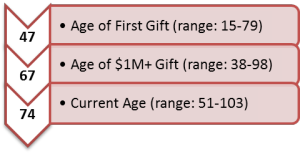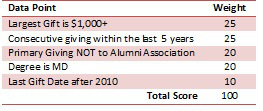
By Faön Mahunik, Executive Director of Research and Analytics, CCS
Data mining, or the process of collecting researching and analyzing data to determine patterns and trends, can be a useful exercise to provide information and usable knowledge to your non-profit organization. It can be used for development professionals to uncover potential “gems” in your database, or to find new prospects through a variety of free and paid-for resources. Today, I’ll review two common excavation techniques: donor profiling and simple scoring, as well as discuss why data mining can be helpful to your organization.
Donor Profiling or “Surface Mining”
It can be incredibly helpful to skim the surface of your database to conduct very basic donor profiling for your organization. Research and exploring data for this purpose can help you define what the best constituent or “prospect” looks like for… your organization, while also finding helpful data to support the profile. As mentioned, data profiling can be used on internal data that your organization is collecting, such as event attendance, age, and historical giving, as well as external data such as wealth screening information, or significant wealthy zip codes.
When conducting donor profiling, you want to think about how you can take the data that you have access to and use it to help determine or support specific strategies. For example, as part of a comprehensive assessment for a healthcare institution, we found that 60% of previous campaign commitments were from those individuals who gave $1 million or more to the organization, so we found it necessary to explore the behaviors and characteristics of those donors. Some of the analysis and questions we asked of the data included: How many donors do we have at this level? Are there any trends in terms of age? Can we learn anything about their giving trends? Below is an example of the age analysis, including the average age at specific time points, on those $1 million-plus donors. Further exploration found that most donors were stewarded for 20 years from their first gift to the first $1 million-plus gift to the organization.

This kind of data mining and profiling can be very helpful to the cultivation process, and can be instructive to your organization in terms of allocating time and energy to certain strategies.
Simple Scoring or “Underground Mining”
If you dig deeper into the database and explore a number of data points that are interesting to your organization, you might be able to build a very simple affinity score for your organization. Affinity can be described as a prospect’s link to an organization, and we often say those who are most connected to an organization have the greatest affinity. Data that may be interesting to use for a simple score can include: constituency type; frequency of giving; membership status, event status; annual report recipient; and total giving. However, any data in your database that tracks or defines the donor or donor giving behavior is up for grabs! The most interesting data points may even be ones that are unique to your organization.
Once you select a few data points that are of interest you can begin the process of building a score by ranking the ones that are most important and assigning weights to each variable in terms of importance. Below is an example of this process, from one of our higher education clients who were focusing on specific degree donor recipients for a targeted event invite.

There are no wrong answers with simple scoring, which can always be revised or adjusted during the process. This simple technique can help you use data to segment and target prospects in your database quickly.
Extracting and Processing
Data mining can be used for a variety of purposes within an organization, and can help guide strategies around donor engagement, donor development and fundraising efficiency. We can use information gleaned from analysis to help prioritize which prospects should receive our greatest attention, use information to assign prospects to the appropriate staff member, and help make more informed asks (based on the data we have both internally and externally), which all directly impacts how effective we are being as an organizations.
No Heavy Machinery Needed
Unlike coal or mineral resource mining, no heavy machinery is needed to conduct basic data mining for fundraising. One only needs to have an interest in exploring data and giving patterns, access to the information that’s being collected in your organization’s database, and the ability to use Microsoft Excel, or a similar spreadsheet program.
How is your non-profit organization using data mining?
Comment below, email info@ccsfundraising.com or share your ideas on LinkedIn, Facebook or Twitter. Visit CCS’s website to learn more about how CCS is helping extraordinary organizations champion inspirational causes. Connect with author, Faön Mahunik, on Twitter via her handle @CCSAnalytics.
Be sure to view CCS’s most recent webinar recording on data strategy, “The Fundraiser’s Guide to Data-Driven Strategy,” which was originally broadcast on May 20th. The session discussed how data can drive strategic decision making and donor cultivation and solicitation, as well as help inform the resource development strategies that should be considered.